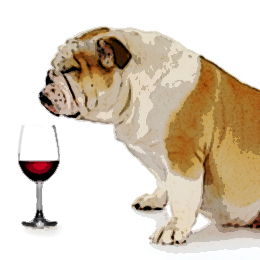Get In Touch With Texture; Tannin Versus Dryness.
Chapter Two, Part Three.
 Texture is paramount to appreciating wine so I put a great deal of emphasis on deciphering its tactile sensations. When describing wine make note not just of the aroma and taste, but of how the wine feels. Now I know a lot of you guys get a little queasy talking about your feelings, so I promise to get through this quickly, even if it takes all night.
Texture is paramount to appreciating wine so I put a great deal of emphasis on deciphering its tactile sensations. When describing wine make note not just of the aroma and taste, but of how the wine feels. Now I know a lot of you guys get a little queasy talking about your feelings, so I promise to get through this quickly, even if it takes all night.
Wines come in a variety of textures, some of which will appeal to you, and some of which will not. When you first taste wine ask yourself “How do I describe the texture of this wine?” Does it feel harsh or silky? Is it lean and austere or rich and flamboyant? Do you find it thin or fat, wimpy or muscular? The weight of wine is also perceived by your sense of touch. Does the wine feel light or heavy in your mouth?
Many wines are described as crisp in texture. You may like that quality in a Pinot Grigio or a $100 bill but dislike it in Grenache. Other wines are said to be creamy. Once again, this may be a desirable trait for Merlot or some Chardonnays but creamy is not a trait you look for in Navy seals or Grüner Veltliner.
Read MoreThe Wine Review Review #1.
 WineSnark recently turned four months old and as I looked over the results I found a few surprises. I learned that my favorite posts are not always your favorite posts. Where I like the snarcastic posts such as “Wine Gladdens The Heart Of Man” or the creative posts like “The History Of Wine And Food Pairing” many of you preferred posts that featured wine reviews – like “Spot The Frog“.
WineSnark recently turned four months old and as I looked over the results I found a few surprises. I learned that my favorite posts are not always your favorite posts. Where I like the snarcastic posts such as “Wine Gladdens The Heart Of Man” or the creative posts like “The History Of Wine And Food Pairing” many of you preferred posts that featured wine reviews – like “Spot The Frog“.
Oddly enough I’ve often been told “I didn’t know WineSnark reviewed wines” and those who did read the reviews often remarked “Maybe WineSnark shouldn’t review wines.”
For those readers who never get to the bottom of the page where the wine reviews are usually located I’ve decided to create a new feature called “The Wine Review Review.” Every few months I’m going to present the best wine descriptions from recent WineSnark reviews, but rather than bore you with the same redundant language found in every other blog or wine magazine I’ve distilled these down to their snarky core.
Without further ado here are,
30 Wine Descriptions You’ll Never Read In The Wine Spectator
Read MoreThere’s No Accounting For Taste.
Chapter Two, Part Four.
 Imagine you’re sitting at a desert resort when you spot a man dragging his haggard body across the sand. The tattered remains of his clothes cling to his emaciated body. His face is covered by a week-old beard. He looks up at you pleadingly.
Imagine you’re sitting at a desert resort when you spot a man dragging his haggard body across the sand. The tattered remains of his clothes cling to his emaciated body. His face is covered by a week-old beard. He looks up at you pleadingly.
“Good Lord man!” you cry. “You must be thirsty. Here, have some wine!”
In a raspy voice he croaks, “How many points did it score?”
Now I don’t want to get off on a rant about the wine rating system, but have you ever noticed that a wine that tastes great to The Wine Spectator or The Wine Advocate doesn’t always taste so great to you?
Read MoreThe History of Wine & Food Pairing.
Chapter Nine, Part One.
 In the beginning God said, “Let there be white.” And there was white.
In the beginning God said, “Let there be white.” And there was white.
And God tried the white, and it was good. And God divided the white from the red, and God was pleased when Robert Parker rated them both 90 points.
And God formed Adam and Eve and placed them in the Garden of Eden.
And Adam said unto Eve, “God has blessed us with both white and red. Hast thou chosen one to compliment this apple?”
“Thy yonder slithering-sommelier suggests Zinfandel,” said Eve.
“That’s original, Zin!” cried Adam.
And so it began, the age-old debate over which wine to serve with dinner. To guide the perplexed people through this culinary quandary, rule-makers stepped forward and created The Rule. They righteously preached that wine and food pairing is done with your eyes and not your mouth, for they looked at wine and decreed; White wine with fish. Red wine with meat!
Read MoreThe Nose Knows.
Chapter Two, Part Two.
 The most revealing aspect of wine analysis comes from olfaction, the sense of smell. Odorants are sensed by olfactory receptor neurons in the nose, or as they’re more commonly called, smell buds. O.K., I just made that up. They’re not really called smell buds, but it’s my blog and I’ll call them whatever I want. Besides, olfactory receptor neuron sounds like some kind of hi-tech weapon used to deduce wines complex aromas, you know, one of those weapons of mass deduction.
The most revealing aspect of wine analysis comes from olfaction, the sense of smell. Odorants are sensed by olfactory receptor neurons in the nose, or as they’re more commonly called, smell buds. O.K., I just made that up. They’re not really called smell buds, but it’s my blog and I’ll call them whatever I want. Besides, olfactory receptor neuron sounds like some kind of hi-tech weapon used to deduce wines complex aromas, you know, one of those weapons of mass deduction.
Humans possess about 40 million smell buds. To put that in perspective your average dog has about 68 billion smell buds, yet oddly enough there are only a couple of dogs writing for The Wine Spectator.
Read More



















